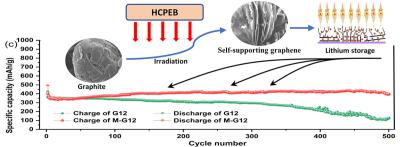Researchers at China's Guilin University of Electronic Technology, China Nonferrous Metals (Guilin) Geology and Mining Co., Ltd., Dalian University of Technology and Reliability Physics and Application Technology of Electronic Component Key Laboratory have developed a method to enhance the energy storage performance of lithium-ion batteries, involving the modification of natural graphite through irradiation with a high-current pulsed electron beam (HCPEB).
The method relies on HCPEB to prepare self-supporting graphene without pollution irradiation. The team reported that graphite was instantaneously transformed into defective graphene structures and that the resulting graphene electrodes exhibited excellent lithium storage and cycling properties.
Microscopic observations reportedly revealed that during the in-situ transformation of graphite particles into self-supporting graphene nanosheets, the high temperature generated by HCPEB irradiation led to the formation of structural defects, including Stone Wales and double vacancy defects. Consequently, the modified natural graphite electrode (particle size 12 μm) exhibited a reversible capacity of 420.4 mAh/g at 0.2C and maintained 94.5% of its reversible capacity after 500 cycles. In comparison to unmodified graphite (particle size 12 μm), the SEI film displayed enhanced stability, significantly improving cycling performance.
These findings demonstrated that the defective graphene nanosheet structure enhances lithium storage activity sites, enlarges layer spacing, and enhances lithium storage performance.
This study presents an efficient and environmentally friendly method for producing superior anode materials for lithium-ion batteries.
